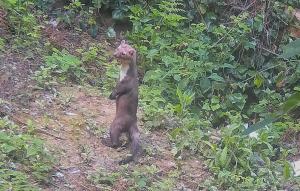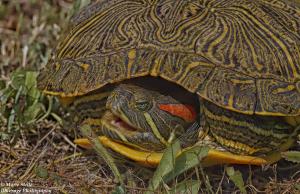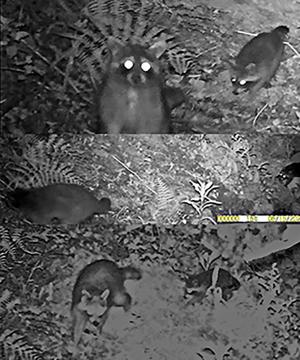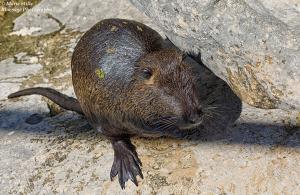Survey of Corfu’s Larger Mammals
SURVEY OF THE LARGER TERRESTRIAL MAMMALS AND THE ALIEN INVASIVE VERTEBRATES OF CORFU:
The survey of Corfu’s larger mammals, the first since 1962, together with the investigation of the distribution of the invasive alien vertebrate species that unfortunately occur on the island, have been successfully concluded and the results published in scientific journals in 2021
Thanks to these two studies we now have relevant information on the present status of the island’s larger terrestrial mammalian species, their habitats and the threats they may face. This basic information is vital as it not only creates the baseline for further studies but also forms the foundation for necessary conservation work. Fortunately, species such as the Beach Marten, Least Weasel, Northern White Breasted Hedgehog and Red Fox still have viable populations on the island, and the Beach Marten is extremely common. However, most of the studied species are still subjected to threats such as habitat loss, habitat fragmentation, death by traffic and illegal hunting.
The Eurasian otter is considered Endangered in Greece and it is only present on a few Greek islands, including Corfu. It is listed in Annexes II and IV of the European Habitat Directive (92/43/EEC and protected in Special Areas of Conservation of the Natura 2000 Network (European Environment Agency, 2015). It is also listed in Appendix I of CITES and included in the Bern Convention.
Otters are secretive animals and mainly nocturnal and otter surveys are generally done by locating tracks, spraint (droppings) and by using camera traps. We have managed to capture the elusive otter on camera in several of Corfu’s waterways, but based on tracks and spraints we must conclude that the number of individuals present is low.
Corfu used to be rich in otter habitats, but many wetlands have been lost, access to estuaries have been restricted or lost altogether, and the outtake of surface water has increased. Many streams and river outlets have also been deliberately blocked, making it more difficult for otters, which generally have large home-ranges, to move between suitable habitats. The Antinioti lagoon and the Tiflos or Fonissa river, the latter recently added to the Natura 2000 network, are presently the two most important areas for otters, but the preservation of all lagoons, wetlands, ponds, and rivers and estuaries is vital for this specie’s survival.
See these otters caught on camera swimming and feeding together!

The Wild Boar is a native species that is present on the Greek mainland and that also used to be present on Corfu. The species has been hunted to extinction in many areas in Europe but has been reintroduced, both deliberately and accidentally. The species has been held in captivity on Corfu from where it has escaped, but we also have photographic evidence for an individual entering the island by swimming from the mainland. We also have photographic evidence of the occurrence of piglets and can conclude that the species is breeding on the island. Although a native species, the reintroduction of the wild boar to densely populated areas where no natural predators are found pose problems. A sow can produce more than one litter per year and the population growth can be rapid. The presence of wild boars has caused conflicts with human interests in many areas in Europe and created economic problems due to destruction of crops, damage to young forests, and destruction of gardens, and the species need to be closely monitored.
Corfu is, due to its location and climate, rich in both species and habitats, but a rapid increase in tourism and intense development, especially along the island’s coastlines, have led to both loss and fragmentation of habitats, putting many species at risk. Habitat fragmentation makes it difficult for animals with large home ranges to move between suitable areas and may also in general force species to search for and move between suitable areas, each being too small. This causes problems for most of the animals in our study but especially so for the otter.
Three alien invasive vertebrate species are present on Corfu, the Coypu, the Raccoon and the American Pond Slider.



Alien invasive species are considered to be a major threat to biodiversity as they compete with native species for resources such as food and breeding grounds. They have the ability to change native habitats, they have rapid reproduction and growth rate, high dispersal ability, and a great capability to adapt to new environments. They cause damage to infrastructure and crop and can carry diseases that can spread to the native fauna. Unfortunately, the Coypu has now spread to all waters on the island while both the Raccoon and the Pond Slider so far have limited distribution. However, this may quickly change if appropriate actions are not taken. All three species are included in the European Union list of species that should be removed from all member states.
Studies like the above are important as they function as baseline both for further studies and for decisions on conservation issues and they should be followed up regularly.
The full reports: «Alien and invasive terrestrial vertebrate species on Corfu, Ionian Islands, Greece” και «Larger mammals of Corfu, Ionian Islands, Greece – Status and potential threats” can be accessed here.
